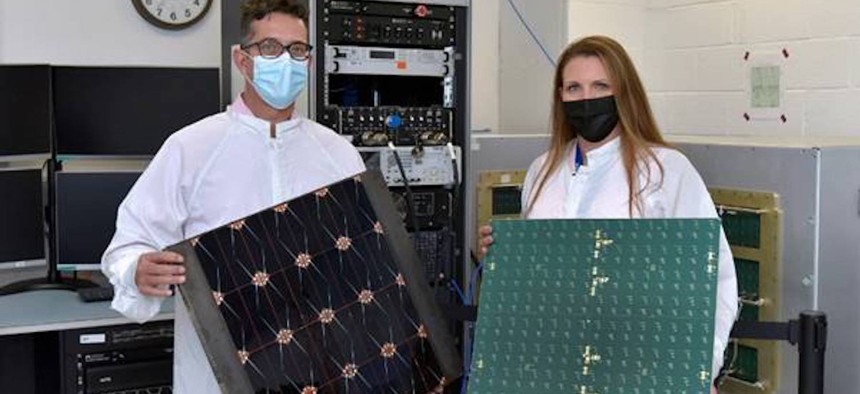
Project Managers James Winter (Air Force Research Laboratory) and Tara Theret (Northrop Grumman) hold models of the photovoltaic and the radio frequency sides of the sandwich tile, while at the Linthicum, Maryland facility, to witness the conversion and beaming experiment. Northrop Grumman courtesy photo
Air Force Breakthrough Brings Space-Based Solar Power One Step Closer
Tomorrow’s remote military bases could be powered by a light-to-microwave tile that just passed a key test.
What’s the best way to power the remote bases of the future? The U.S. military has looked at all sorts of options, from algae-based diesel to small nuclear reactors. On Tuesday, the Air Force Research Lab, or AFRL, announced a breakthrough in a long-envisioned method: solar power collected in space and streamed to Earth in the form of microwaves.
There’s more solar energy to be harvested in orbit than on the ground, where the sun’s rays are attenuated by atmospheric gases and dust. The problem is getting that power to where it needs to be. AFRL’s, Space Solar Power Incremental Demonstrations and Research, or SSPIDR, program seeks to beam it down to Earth in the form of microwave energy that can penetrate dust and clouds and be collected a special antenna called a rectenna. From there it can be converted into DC power to run a base.
AFRL and Northrop Grumman are developing a tile to convert light energy, which has a wavelength of about 400 to 700 nanometers, into microwaves (about 1 to 300 millimeters). On Tuesday, the lab announced that the tile had passed a critical test.
“This is what makes us believe that we can do this, that this is actually feasible now,” said Rachel Delany, a mechanical engineer with AFRL, in conversation wth Defense One.
The job now is to continue to engineer the panels to be smaller, so they’re easier to lift into orbit; and more efficient, so that less energy is lost converting light to microwaves and sending the energy Earthward.
“Normally with space photovoltaics, we're looking around 30 to 40% efficiency. But the biggest loss comes from that conversion process. And then getting [power] back to the ground,” said Kyle Gleichmann, another AFRL mechanical engineer.
But there are a lot of other things that have to happen between now and 2025, when the group expects to do their first test of the beaming in space. The team is “looking at the science of beaming,” learning how to focus available energy into a tight, narrow beam, Gleichmann said. Another challenge is making tiles that can withstand the huge temperature differences between sunlight and shadow in orbit. Finally, the team is studying how to design and build large deployable structures to hold the tiles.
Over the years, groups around the world have pitched space-based solar power projects, from giant constellations of orbiting solar panels constructed in space by robots to a ring of solar panels encircling the moon.
Delany and Gleichmann say that while solar energy can be collected more efficiently in space, that doesn’t mean that it’s a substitute for solar power on Earth. Delany estimated that some 1,000 square meters of tiles would be necessary just to power one forward operating base. However, space-based solar could provide energy to remote places that have no other way to get power and it could decrease reliance on carbon-producing fossil fuels.
“What's interesting, and what's useful about using radio frequency, is that you can beam that power down regardless of time of day because it goes through clouds,” said Delany. “If it's cloudy out, your solar cells on your house aren't going to work, or if you're in…a higher latitude solar power isn't an option because you can't get the right angle. But if you use [radio frequency] energy to transport that power, you could provide solar power regardless of time of day and regardless of latitude. So that's the difference is between having solar panels on your roof versus getting that power from space.”







